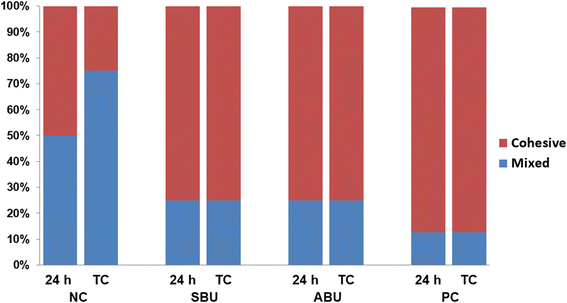Performance of universal adhesives on bonding to leucite-reinforced ceramic
- PMID: 26331081
- PMCID: PMC4552369
- DOI: 10.1186/s40824-015-0035-1
Performance of universal adhesives on bonding to leucite-reinforced ceramic
Abstract
Background: This study aimed to investigate the microshear bond strength of universal bonding adhesives to leucite-reinforced glass-ceramic.
Methods: Leucite-reinforced glass-ceramic blocks were polished and etched with 9.5% hydrofluoric acid for 1 min. The specimens were assigned to one of four groups based on their surface conditioning (n = 16): 1) NC: negative control with no further treatment; 2) SBU: Single Bond Universal (3M ESPE); 3) ABU: ALL-BOND Universal (Bisco); and 4) PC: RelyX Ceramic Primer and Adper Scotchbond Multi-Purpose Adhesive (3M ESPE) as a positive control. RelyX Ultimate resin cement (3M ESPE) was placed on the pretreated ceramic and was light cured. Eight specimens from each group were stored in water for 24 h, and the remaining eight specimens were thermocycled 10,000 times prior to microshear bond strength evaluation. The fractured surfaces were examined by stereomicroscopy and scanning electron microscopy (SEM).
Results: After water storage and thermocycling, the microshear bond strength values decreased in the order of PC > SBU and ABU > NC (P < 0.05). Thermocycling significantly reduced the microshear bond strength, regardless of the surface conditioning used (P < 0.05). Cohesive failure in the ceramic and mixed failure in the ceramic and resin cement were observed in the fractured specimens. The percentage of specimens with cohesive failure after 24 h of water storage was: NC (50%), SBU (75%), ABU (75%), and PC (87%). After thermocycling, the percentage of cohesive failure in NC decreased to 25%; however, yet the percentages of the other groups remained the same.
Conclusions: Although the bond strength between resin and hydrofluoric acid-etched glass ceramic was improved when universal adhesives were used, conventional surface conditioning using a separate silane and adhesive is preferable to a simplified procedure that uses only a universal adhesive for cementation of leucite-reinforced glass-ceramic.
Keywords: Leucite-reinforced ceramic; Microshear bond strength; Resin cement; Thermocycling; Universal adhesive.
Figures



References
-
- Sorensen JA, Engelman MJ, Torres TJ, Avera SP. Shear bond strength of composite resin to porcelain. Int J Prosthodont. 1991;4:17–23. - PubMed
-
- Barghi N. To silanate or not to silanate: making a clinical decision. Compend Contin Educ Dent. 2000;21:659–62. - PubMed
-
- Chen JH, Matsumura H, Atsuta M. Effect of etchant, etching period, and silane priming on bond strength to porcelain of composite resin. Oper Dent. 1998;23:250–7. - PubMed
LinkOut - more resources
Full Text Sources
Other Literature Sources

